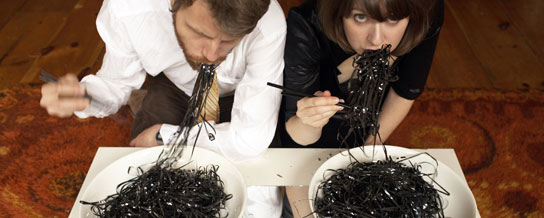Five Star by Free Blood
Experimental soulsters Madeline Davy and John Pugh of Free Blood discuss their favorite lords of […]

Five Star by Free Blood
Experimental soulsters Madeline Davy and John Pugh of Free Blood discuss their favorite lords of […]

Experimental soulsters Madeline Davy and John Pugh of Free Blood discuss their favorite lords of the dance.
Busby Berkeley
Busby Berkeley is responsible for the classic style of movie-musical choreography yet his stuff stands as some of the most experimental and psychedelic. He was never hesitant to spend studio money on his vision, even it meant building a giant fountain or an orchestra of violins outlined in neon. Berkeley exploded perspective by moving the camera around, beneath, and above the dancers. The scenes build in visual density until the human forms become completely abstract.
Michael Clark
Like Berkeley, Clark often works with camera angles and editing. “Because We Must, Part 3” has a beautiful overhead scene of dancers moving their bodies and guitars together to form shapes. He makes hyper-relevant pieces, often collaborating with contemporaries from other fields like Wire and Leigh Bowery. He also has great pieces exploring the movements of one body. “Shivering Man” shifts between a nimble pixie character and a man who shakes uncontrollably.
David Byrne
The Talking Heads’ “Once in a Lifetime” video plays off this idea of the body’s limitations. David Byrne spazzes and jerks in a way that makes it seem as if his body is in control of him and not the other way around–there’s a sort of humor involved. The video uses multiple and repeated sequences of his gesticulations to the point where you start to see the buried rhythm in his apparently random dancing/seizures. The repetition creates order, no matter how chaotic.
Bob Fosse
Fosse is the exact opposite of Byrne. He is serious precision in action. As a solo performer and choreographer, Fosse made every move and step so fucking sharp it cuts your eye just watching it. The fingers and toes are all pointed just so. The chin slanted in a very specific angle, either up or down. There are no accidents in Fosse’s work. No camera trickery or weird props. Just one scarily adept performer strutting, swinging, dipping, scraping, and flipping across the stage–all in one take!
Soul Train
The Soul Train dance line is a source of inspiration. The idea of striving to be the freakiest/sexiest/smoothest/whatthefuckingest dancer on the floor is sometimes sorely lacking from dance parties. If we all had just 20 seconds to show our stuff, you’d want it to count, right? Dancing with friends when you’re trying to shock or just crack each other up is when you come up with your best moves.

